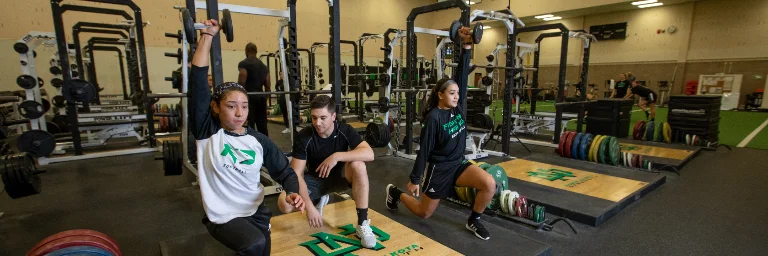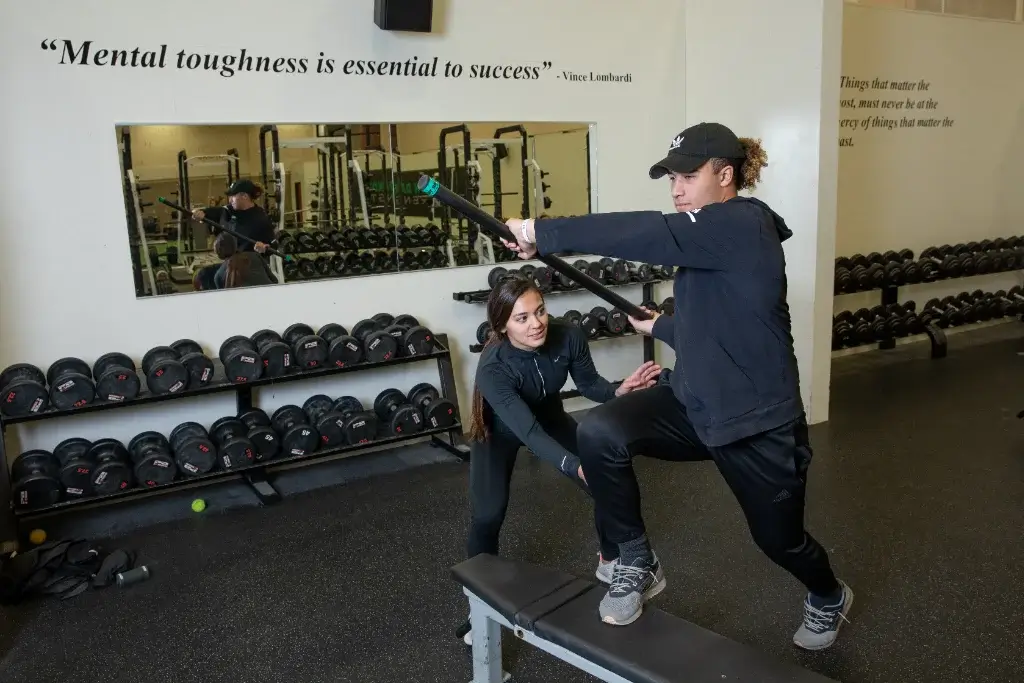
What is Kinesiology? A Comprehensive Guide
Like a well-tuned instrument, your body needs precision, balance and optimal functioning to achieve greatness.
Request Information
This is where the role of a kinesiologist becomes analogous to that of a skilled conductor orchestrating a symphony of movements. Just as a conductor harmonizes each instrument to create a masterpiece, a kinesiologist meticulously assesses the body’s movements, fine-tuning its mechanics to ensure peak performance.
If you’re intrigued by the captivating field of kinesiology and are wondering, “What is kinesiology?” then come along as we examine the historical roots, diverse applications and techniques of kinesiology: the science of movement.
Definition and History of Kinesiology
Kinesiology, rooted in the Greek term “kinesis,” signifying movement, and the suffix “-ology,” denoting a science or branch of knowledge, is fundamentally the study of human movement. Its historical roots trace back to the ancient philosopher Aristotle, often called the “Father of Kinesiology.” His work, “On the Motion of Animals” or “De Motu Animalium,” marked a pivotal moment by providing a geometric analysis of muscle actions, laying the foundation for studying movement.
Later on, in the 16th century, anatomist Andreas Vesalius laid the foundation for modern kinesiology by producing detailed drawings and descriptions of the human musculoskeletal system. Then, in the early 20th century, orthopedic surgeon R.W. Lovett laid the groundwork for muscle strength testing, developing a system that later found advancement in Henry and Florence Kendall’s 1949 book, “Muscle Testing and Function.”
The evolution of kinesiology as we recognize it today took another significant leap in 1964 when chiropractor George Goodheart introduced Applied Kinesiology. This approach involved studying muscle response, aligning with the term “kinesiology,” which denotes the study of movement. Goodheart’s innovative methods, effective in addressing complex health issues, were adopted across various healthcare fields.
Today, kinesiology is a thriving and multidisciplinary field, encompassing expertise from improving athletic performance and preventing injuries to developing assistive technologies for individuals with disabilities. Its trajectory highlights a continuous commitment to exploration and growth, leveraging centuries of research and innovation.
Principles of Kinesiology
Kinesiology refers to the study of movement. In American higher education, the term is used to describe a multifaceted field of study in which movement or physical activity is the intellectual focus. Physical activity includes exercising to improve health and fitness, learning movement skills, and engaging in activities of daily living, work, sport, dance, and play. Kinesiology is all-encompassing of the general population and relevant to everyone, not just sports enthusiasts or athletes. Special groups such as children and older adults as well as people with disabilities, injuries, or diseases can benefit from learning the principles of kinesiology and applying them to their daily activities and lives.

Learning and Practicing Kinesiology
Kinesiology is a common name for college and university academic departments that include many specialized areas of study in which the causes, processes, and consequences and contexts of physical activity are examined from different perspectives. The specialized areas of study apply knowledge, methods of inquiry, and principles from areas of study in the arts, humanities, sciences, and professional disciplines. These specialized areas include (but are not limited to) biomechanics, psychology of physical activity, exercise physiology, history of physical activity, measurement of physical activity, motor development, motor learning, and control, philosophy of physical activity, physical activity and public health, physical education pedagogy, sport management, sports medicine, and the sociology of physical activity. An interdisciplinary approach involving several of these areas is often used in addressing problems of importance to society.
Educational Path<
A Kinesiology degree is an academic program that studies human movement, performance, and function. It integrates knowledge from various disciplines, including anatomy, physiology, biomechanics, psychology, neuroscience, and nutrition, to comprehensively understand how the human body moves and operates. This degree is designed to explore the principles of physical activity and its impact on health, wellness, and disease prevention.
Kinesiology programs often offer a variety of specializations, such as exercise science, physical education, rehabilitation, public health education, and sport management. These specializations allow students to tailor their education towards specific career goals in health promotion, fitness and wellness consulting, sports coaching, rehabilitation services (PT/OT/AT/ST/PA), and beyond.
The curriculum typically includes both theoretical coursework and practical experiences. Students engage in laboratory work, internships, and research projects that apply classroom knowledge to real-world settings. This hands-on approach not only enhances learning but also prepares graduates for professional practice in diverse settings, including hospitals, wellness centers, schools, sports organizations, and research institutions.
Graduates with a Kinesiology degree possess a deep understanding of the biomechanics of movement, the physiological responses to exercise, and strategies for promoting physical and mental well-being. They are equipped to pursue careers in health and fitness industries, rehabilitative sciences, sports coaching and performance analysis, health policy, and education, among others.
A Kinesiology degree offers a holistic and interdisciplinary approach to studying the body and its movements, aiming to improve human health, performance, and quality of life through physical activity.
Examples of courses in Kinesiology include:
- Introduction of Kinesiology: Explores the study of human movement, integrating principles from anatomy, physiology, biomechanics, and psychology to understand and enhance physical activity and health.
- Anatomy and Physiology: Detailed study of the human body's structure and function.
- Biomechanics: Examines the mechanical principles that govern human movement.
- Exercise Physiology: Looks at how the body responds and adapts to physical activity.
- Motor Learning and Control: Focuses on how we learn and refine movements.
- Sports Nutrition: Studies the role of diet in athletic performance and health.
- Strength and Conditioning: Teaches training principles to improve performance and prevent injuries.
- Health and Wellness Promotion: Focuses on strategies to encourage healthy lifestyles.
- Teaching Methods in Primary/Secondary Physical & Health Education: Curriculum and instructional models, national curriculum standards, teaching methods in PE.
- Motor Development: Knowledge and practice about physical growth, biological maturation, and motor development and their interrelationship in human performers. Particular emphasis is placed on assessing and developing basic movement skills through programming strategies for individuals and large groups.
- Sports Psychology: Explores psychological factors that affect performance and physical activity.
- Esports: Introduction to esports, esports coaching, esports health and wellness, and moral principles in esports.
- Research Methods in Kinesiology: Provides an understanding of research design and analysis in studying human movement.
In addition to online and on-campus traditional options for both bachelor’s in Kinesiology as well as master’s in Kinesiology degrees, the University of North Dakota (UND) offers an accelerated Kinesiology degree alternative that combines bachelor’s and master’s studies, allowing students to swiftly progress in their educational journey.
Professional Opportunities
Kinesiology degree jobs span across various fields, including health and wellness, sports and fitness, rehabilitation, education, and research. Graduates can pursue careers such as physical therapists, exercise physiologists, sports coaches, occupational therapists, physical education teachers, fitness trainers, biomechanists, and wellness consultants.

The degree also provides a foundation for further study in fields such as medicine, chiropractic, and physiotherapy, emphasizing the diverse applications of kinesiology knowledge. For more detailed information, please refer to the American Kinesiology Association's website on careers in kinesiology.
Conclusion
As long as there are humans on the earth, there will always be a need for kinesiology. The study of kinesiology, or human movement, can lead to a variety of careers in areas including sports and fitness, healthcare and rehabilitation, and more. The choice of Kinesiology as a field of study at the undergraduate level also prepares students for professional graduate study in a wide variety of allied health and medical professions. Positions are found in various settings, including schools, colleges and universities, public and private agencies, clinical environments, government, business, and the military.
If you’re inspired to become a part of this transformative field, consider joining us at the University of North Dakota. Our bachelor’s in Kinesiology and master’s in Kinesiology degrees provide an exceptional foundation as well as open doors to a myriad of captivating career paths. And for those eager to embark on an expedited yet comprehensive educational journey, our accelerated Kinesiology degree can be an ideal choice.
FAQs
Kinesiology is the study of human movement, performance, and function, while physical therapy, or PT, is a clinical practice that uses various techniques to restore, maintain, and promote optimal physical function. Those aspiring to pursue a career in PT will need to earn a doctoral degree in that area to become board certified. However, a degree in Kinesiology provides a solid foundation for those students who ultimately want to go on to earn their DPT.
Kinesiology professionals are not just limited to sports and fitness-related industries. In fact, kinesiology professionals can be found working in healthcare, corporate wellness, ergonomics, and research, among other sectors.
Kinesiology is a broad field that covers all aspects of human movement, including psychological and neurological factors. Exercise Science is a more narrowly focused field that deals with the physical and physiological aspects of exercise and its effects on the body.
Yes. Research in kinesiology can range from biomechanics, motor learning and control, and sports pedagogy to exercise physiology and sports psychology, often with implications for education, health, rehabilitation, performance, and behavior studies.
Certain professions within kinesiology may require specific certifications, such as a Certified Strength and Conditioning Specialist (CSCS), Physical Education Teacher and Adapted PE teacher (teaching licensure), or Certified Personal Trainer (CPT).